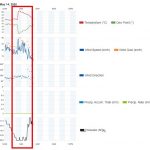
Parts of the Maltese Islands, especially Gozo, experienced a probable heat burst in the very early hours. Starting at 02:19, the air temperature rose rapidly by 6.1°C (from 20.6°C to 26.7°C) in a space of just 20 minutes. Levels of relative humidity also experienced a sharp drop, from a humid 80% to an extremely dry 37%, all in a gap of a few minutes. In typical heat burst fashion, the wind increased dramatically from a complete calm to 40.2 km/h (Force 6) in a matter of minutes. The behaviour of air pressure also reveals tell-tale signs of a heat burst. It climbed by 2hPa, from 1009.5hPa to 1011.5hPa, over the same time period. This lasted for some time, with the air temperature and wind subsiding gradually afterwards.
A rare phenomenon, heat bursts tend to be more likely in the late spring and more specifically at night. Lasting anywhere from a couple of minutes to several hours, the main distinguishing features of heat bursts are sudden strong gusty winds, extreme temperature changes and a drop in humidity.
This probable heat burst can be blamed on a cut-off low pressure system which traversed our area during the night between Wednesday and Thursday. This cut-off low had several embedded isolated thunderstorms within it. Most were in an advanced stage of dissipation. One of these isolated thunderstorms passing just off Gozo’s west coast is the likely culprit. As a thunderstorm starts to dissipate, its clouds rise, leaving a layer of cold air beneath. At this stage, much of the moisture has been eliminated from the air by earlier precipitation. Due to gravity and the rapidly disappearing updrafts (currents of rising air within clouds), the dense air starts to sink to the ground. As its descent accelerates down, the air is subjected to increasing air pressure and friction. The increased atmospheric pressure causes the air to warm under compression ed-hrvatski.com. The friction between falling and stationary air particles creates further heat. All this contributes to the thermal buildup of the sinking air. As the air heats up, any remaining moisture is forced to evaporate. Momentum allows the layer of air to continue to speed up its descent. The result is a heated, dry pocket of air that hits the surface, forcing warm gusty wind to disperse away from this point of impact. A heat burst has been likened to someone blowing down on a puddle of water.
- A graphical representation of the probable heat burst from our weather station in Għarb.
- A tabular representation of the probable heat burst from our weather station in Għarb.




0 comments
Write a comment